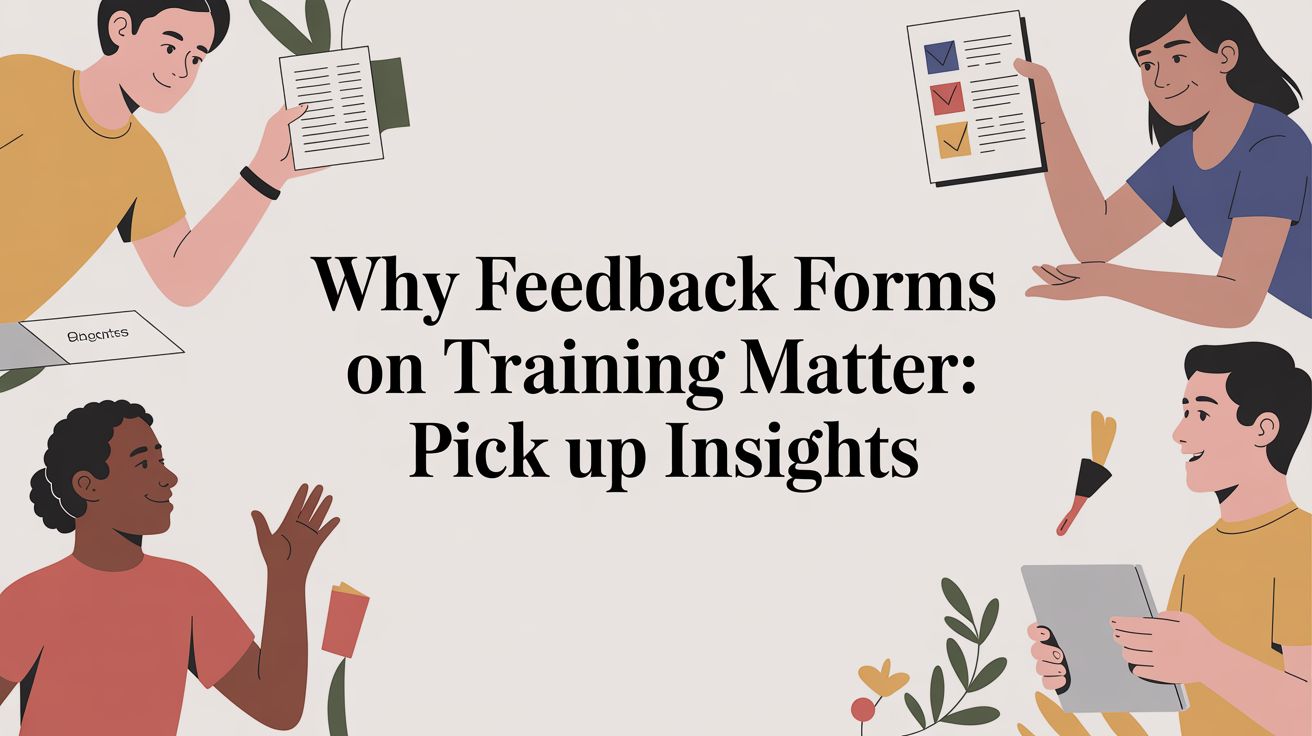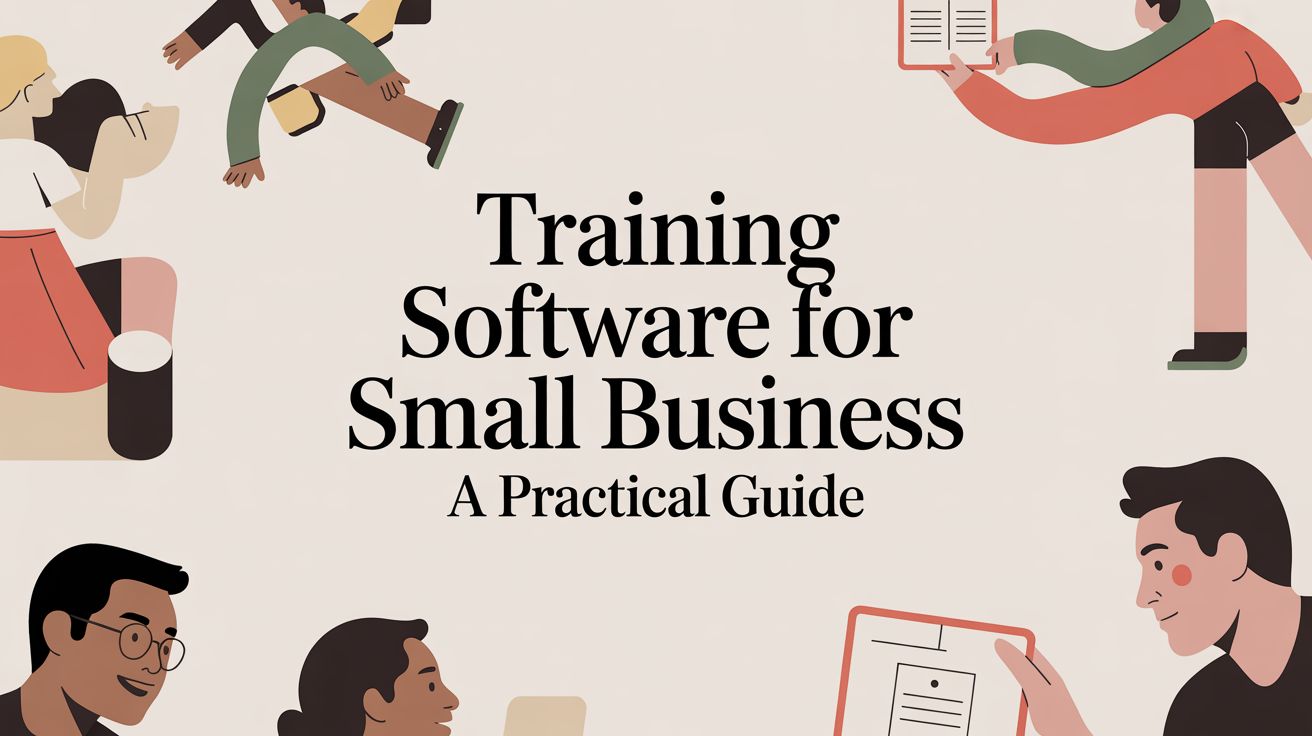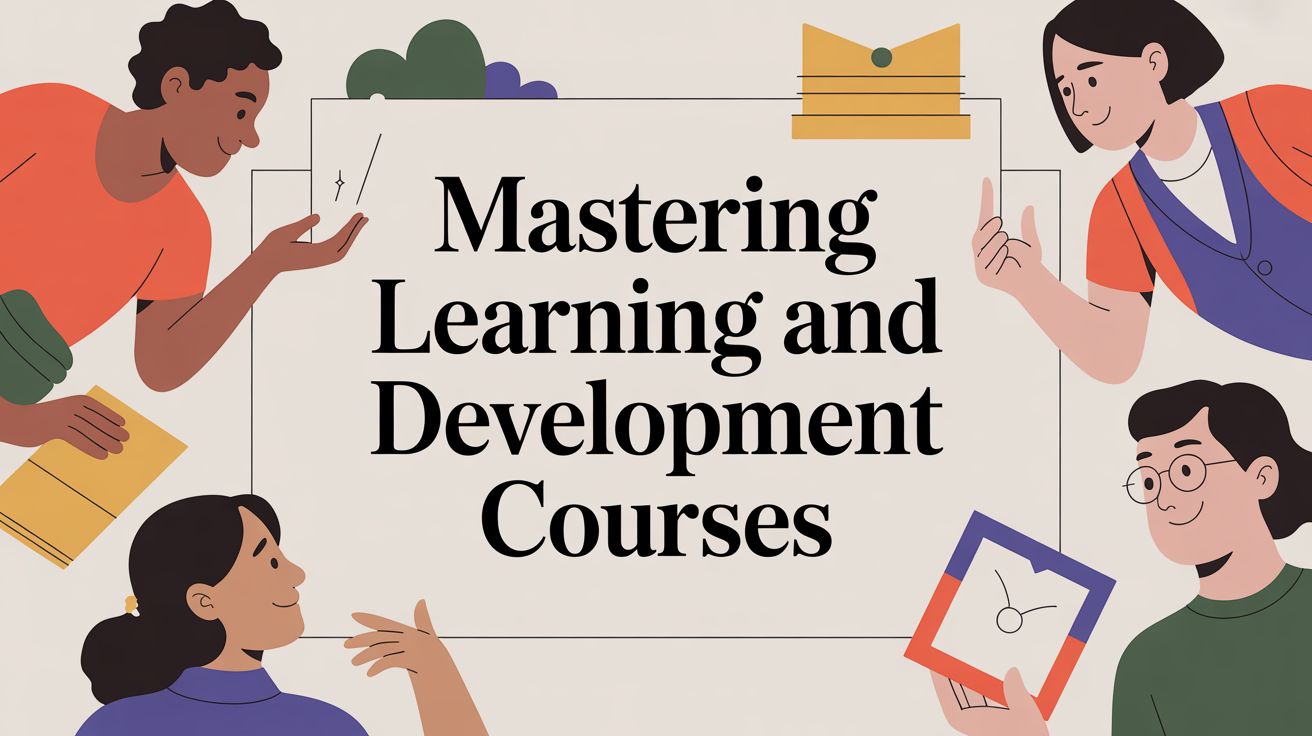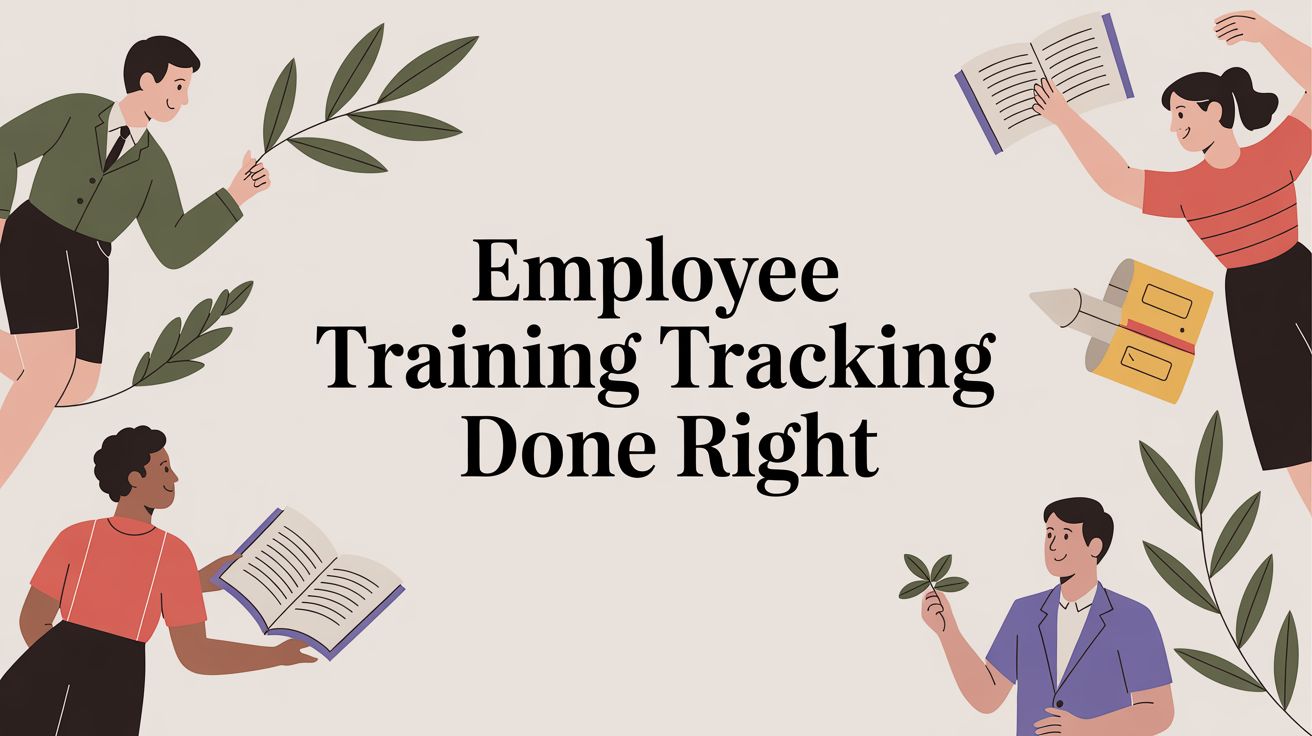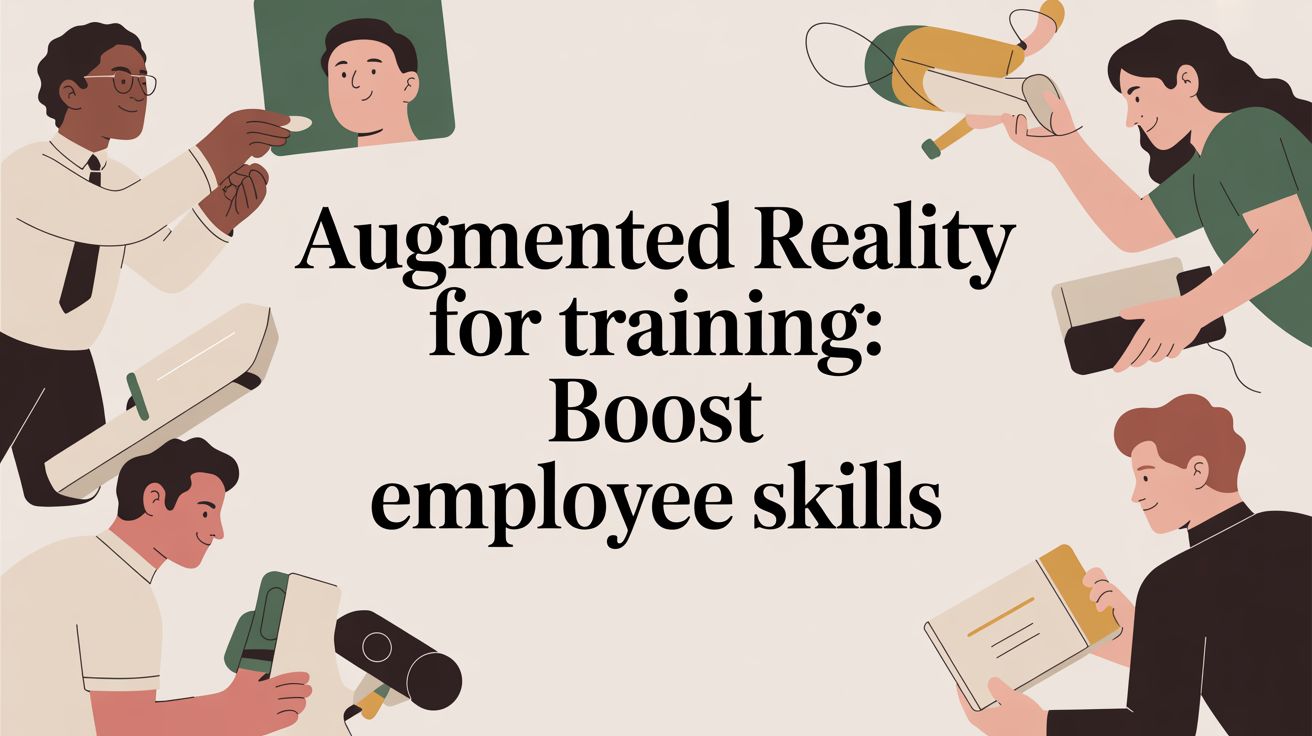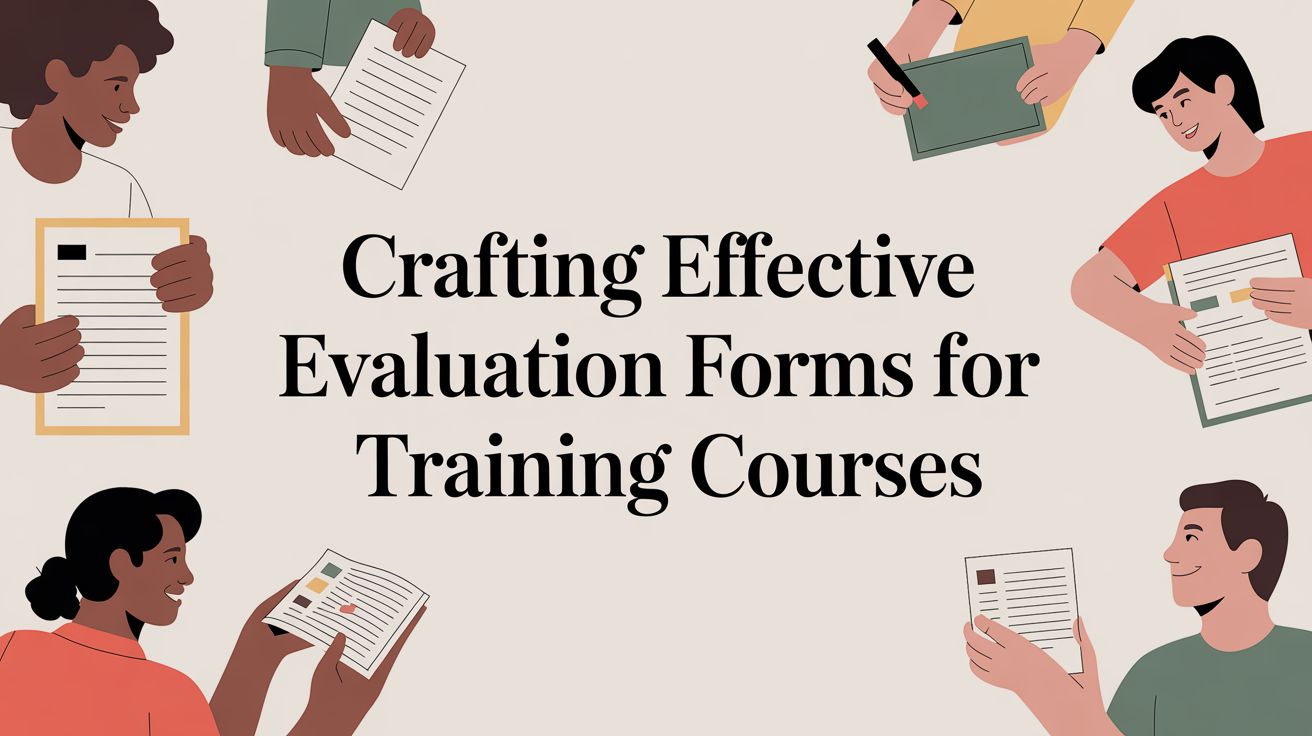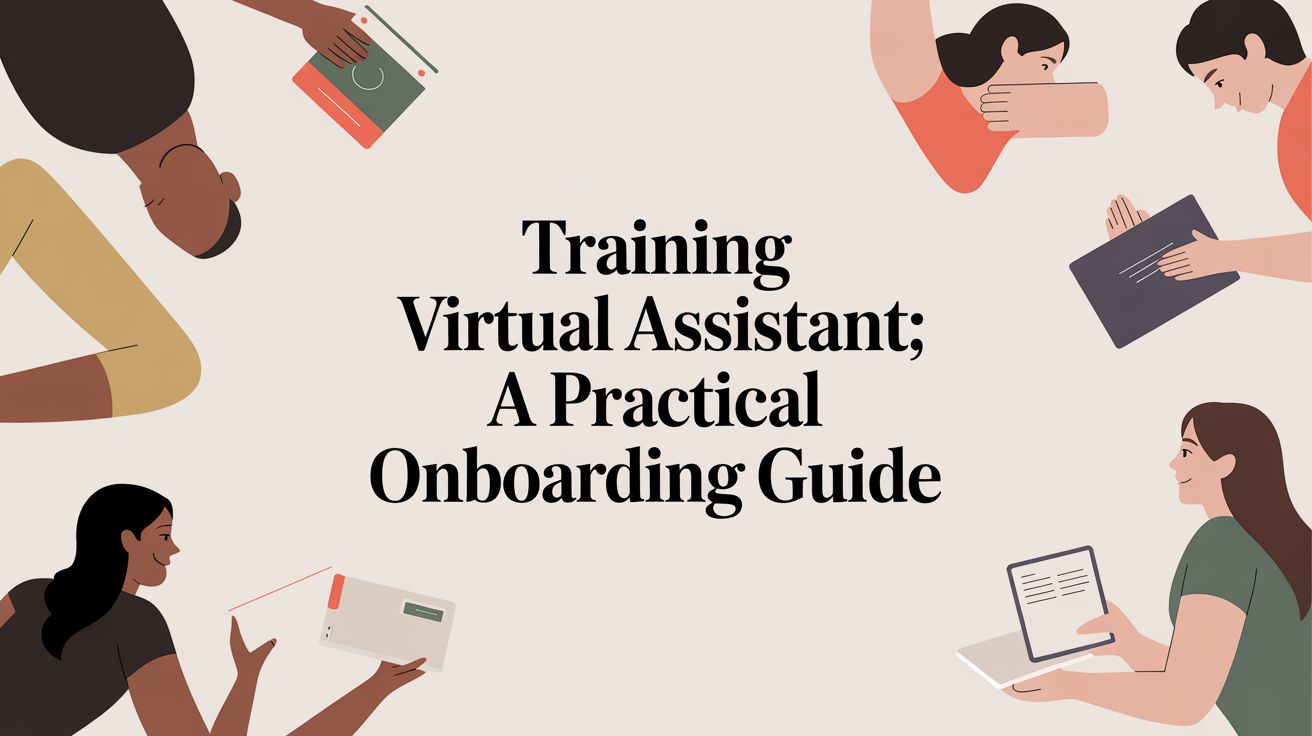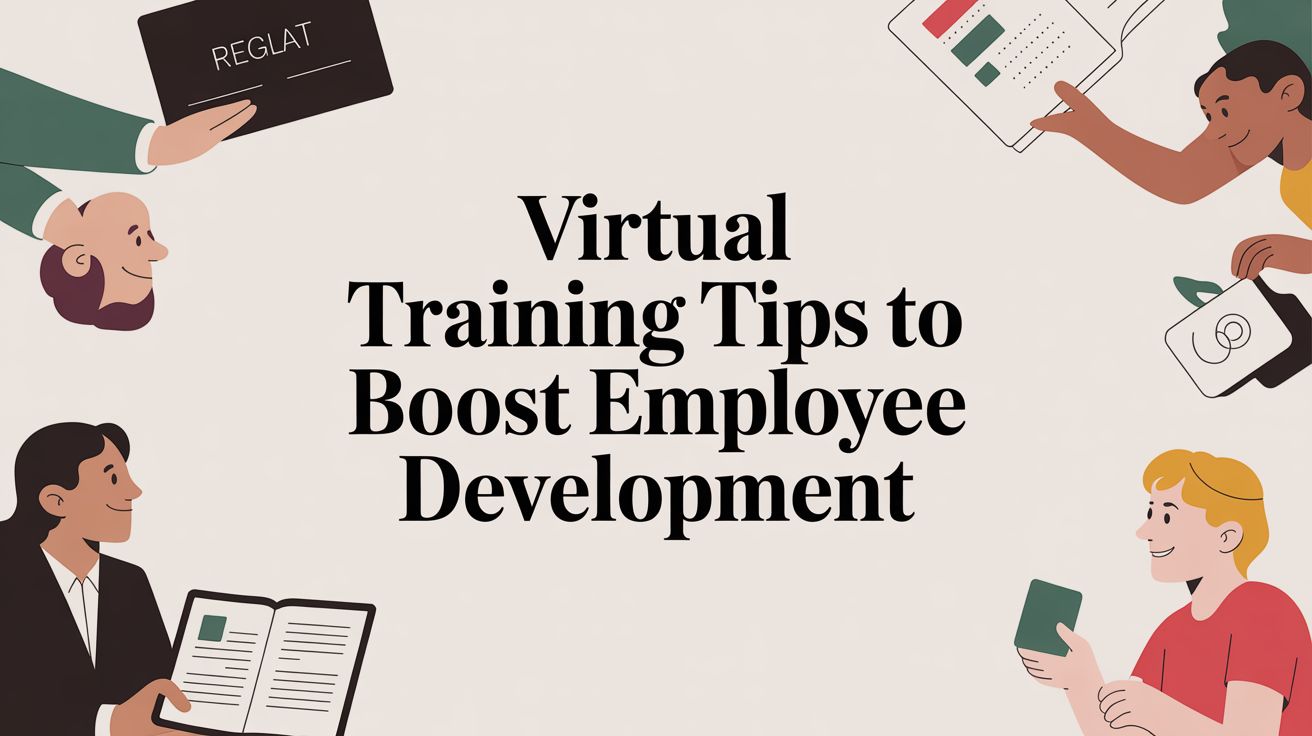Real Estate Training Software to Boost Broker ROI

In the high-stakes world of real estate, the sharpest tool you have isn’t a marketing strategy or a fancy CRM—it’s the quality of your agent training. Yet for many brokerages, managing that training is a chaotic mess of scattered spreadsheets, endless email threads, and a patchwork of calendar invites. This guide will show you how the right real estate training software can tame that chaos and turn it into a streamlined engine for growth.
Why Modern Brokerages Need Specialized Training Software
Let’s be honest: your brokerage is only as successful as your agents. And the single biggest driver of agent success is consistent, high-impact training. But the administrative headache of scheduling courses, tracking who showed up, and making sure everyone’s compliance is up-to-date can quickly become a full-time job. This is where dedicated software stops being a "nice-to-have" and becomes absolutely essential.
Too often, brokerages try to shoehorn their needs into a generic Learning Management System (LMS). The problem? LMS platforms are built for static, self-paced online courses and e-learning. Real estate, on the other hand, thrives on live interaction—energetic workshops, one-on-one virtual coaching, and hybrid classes. That dynamic environment requires a completely different kind of tool: a Training Management System (TMS).
Tip: Think of a Training Management System as the operational backbone for your live, instructor-led training. An LMS is for managing e-learning content, while a TMS is for managing the logistics of the training events themselves.
A TMS is the central nervous system for your brokerage's entire training operation. It’s built specifically to handle the complex logistics of live, virtual, and hybrid events.
The Shift to Purpose-Built Systems
The move toward these specialized tools isn’t just a hunch; it’s a market-wide trend. The real estate license school software market is on track to hit $250 million by 2025, growing at an impressive 15% each year. This boom is fueled by brokerages demanding flexible, scalable training solutions that cut down on administrative work and directly boost agent performance.
This isn't just about adopting new tech—it's a fundamental strategic shift. When you automate the backend logistics, you free up your team to focus on what actually moves the needle.
Key Takeaway: A specialized TMS gets brokerage leaders out of the administrative weeds and back to high-value activities like coaching agents, recruiting top talent, and growing the business.
Instead of drowning in spreadsheets, a TMS like Coursebricks lets you:
- Centralize Everything: Manage all your in-person, virtual, and hybrid courses from a single, easy-to-use calendar.
- Automate Communications: Automatically send registration confirmations, class reminders, and follow-up materials to your agents. No more manual chasing.
- Track Compliance with Ease: Effortlessly monitor continuing education credits and license renewal deadlines.
- Sharpen Agent Skills: Deliver targeted programs that address specific gaps, like a deep dive into competency-based training.
Ultimately, putting money into the right real estate training software is a direct investment in your agents' success, which translates to better agent retention and a more profitable brokerage.
Solving Brokerage Headaches With Smart Automation
Beyond the big-picture vision of growing your agents lies the messy, everyday reality of running a brokerage. Brokerages are constantly fighting administrative fires that eat up time, drain energy, and kill productivity. These aren't just small annoyances; they're major operational drags that hold back growth and frustrate agents.
Just think about the logistical puzzle of scheduling a multi-session course, juggling different instructors, and booking rooms. It can feel like a full-time job. Then, add the high-stakes game of tracking continuing education (CE) credits for state licensing, and the administrative weight becomes crushing. For example, a new agent in Massachusetts has to complete a 40-hour pre-licensing course—a process with multiple steps and strict paperwork requirements.
The Endless Cycle of Manual Management
Without a dedicated system, brokers are stuck putting out one fire after another. They find themselves wrestling with conflicting calendars, chasing down agents for attendance, and spending hours trying to pull together reports from a dozen different spreadsheets. This approach isn't just inefficient; it's a recipe for expensive mistakes.
A missed CE deadline can put an agent's license on the line. A double-booked instructor creates chaos and ill will. These problems only get worse as your brokerage grows, making it nearly impossible to deliver consistent, high-quality training across multiple offices. Every hour spent on these manual tasks is an hour not spent on high-impact activities like coaching top producers or recruiting new talent.
A purpose-built real estate training software is the direct solution, replacing manual chaos with intelligent automation. This isn't just about convenience; it’s about winning back your most valuable asset—time.
How Automation Brings Immediate Relief
A Training Management System (TMS), like Coursebricks, brings order to the chaos by centralizing every training-related activity. Instead of juggling a messy collection of calendars, spreadsheets, and email chains, you get one single source of truth for your entire live education program.
This shift completely changes how a brokerage operates. Consider a few key advantages:
- Centralized Scheduling: Manage all your live, virtual, and hybrid courses from one intuitive calendar.
- Automated Communication: Send out instant registration confirmations, reminders, and follow-up surveys without lifting a finger.
- Effortless Compliance Tracking: Automatically log attendance and monitor CE credit completion against state requirements.
- Smooth Resource Coordination: Easily assign instructors and book venues, eliminating conflicts and making sure everything runs smoothly.
This level of automation frees your administrative team to move from being reactive problem-solvers to proactive program managers. They can finally focus on enhancing the training experience itself instead of just keeping the logistics from falling apart. For instance, a well-managed training program could easily incorporate new topics like voicemail drop strategies for real estate professionals, which would be a nightmare to coordinate manually.
From Manual Chaos to Automated Clarity
Let's look at a side-by-side comparison. The table below shows how a TMS transforms tedious administrative tasks into streamlined, automated workflows, highlighting the stark difference between the old way and the new.
| Common Training Task | The Manual Method (The Headache) | The TMS Solution (The Advantage) |
|---|---|---|
| Course Registration | Manually entering agent data from emails or sign-up sheets into a spreadsheet. | Agents self-register online; data is captured automatically and is instantly available. |
| Attendance Tracking | Passing around a physical sign-in sheet, then manually inputting the data later. | Automated check-ins (QR codes or digital lists) that instantly update agent records. |
| CE Credit Reporting | Manually compiling attendance records and cross-referencing with licensing needs. | Real-time dashboards showing credit status for every agent, with automated alerts. |
| Class Communication | Sending individual emails or group texts for reminders, changes, and follow-ups. | Automated, trigger-based emails for confirmations, reminders, and post-class materials. |
The contrast is clear. Automation doesn't just save a few minutes here and there; it fundamentally changes the operational capacity of your brokerage, allowing you to scale your training efforts without scaling your administrative burden.
What to Look For: The Must-Have Features of Real Estate Training Software
When you start shopping for real estate training software, it’s easy to feel overwhelmed by endless feature lists. But here’s the thing: not all platforms are cut out for the unique, high-stakes world of a real estate brokerage. You need a system that’s more than just a digital filing cabinet for old videos; you need a command center for your entire training operation, especially the live, instructor-led sessions that truly build top agents.
It’s about finding the right tool for the job, not just any tool. The real estate tech market is absolutely exploding—it hit $10.29 billion in 2023 and is on track to more than double to $21.77 billion by 2030, according to Grand View Research. This growth means you have more choices than ever, which makes it critical to know which features actually make a difference for a brokerage that relies on live training.
A purpose-built Training Management System (TMS), like Coursebricks, is designed to master the complex logistics of running a successful and scalable training program. Let's break down the non-negotiable features you should be looking for.
Centralized Course and Event Scheduling
Think of your training calendar as the nervous system of your entire educational program. If you're trying to juggle multiple courses, instructors, and locations—not to mention in-person, virtual, and hybrid formats—with a patchwork of different tools, you’re setting yourself up for chaos. A top-tier platform brings everything together into a single, unified calendar.
This central hub should let you:
- See everything at a glance: From a quick coaching call to a multi-day certification course, every single session should appear in one clean view.
- Filter and organize with ease: Avoid double-bookings and confusion by sorting events by instructor, location, course type, or specific agent groups.
- Simplify complex schedules: Creating a course that spans several days or weeks should be effortless, not a manual nightmare of entering each session one by one.
Automated Registration and Communication
How many hours do your admins spend manually signing up agents for classes, sending out reminders, and chasing people down for feedback? Those hours add up fast. For any brokerage serious about growth, automation isn't a perk; it's a core requirement.
Look for a system that can handle the entire communication flow on its own, from the first invitation to the final survey. Key automation features include:
- An online course catalog and self-registration: Agents should have a simple, branded portal where they can browse available courses and sign up on their own time.
- Smart email and SMS notifications: Set it and forget it. The system should automatically send confirmations, reminders, and Zoom links based on triggers you define.
- Automated waitlists: When a popular class fills up, the software should manage a waitlist and automatically offer an open spot to the next agent in line. No more manual juggling.
Integrated Compliance and CE Credit Tracking
In real estate, compliance isn't just about good record-keeping; it's about managing risk. Manually tracking continuing education (CE) credits and license renewal dates is an open invitation for human error, and a single mistake can have serious consequences for your agents and your brokerage.
A powerful TMS flips compliance from a reactive headache into a proactive strategy. It gives you a real-time, accurate dashboard of every agent's status, ensuring no one ever falls through the cracks.
An effective system has to link compliance tracking directly to course attendance. You need to see exactly who attended which accredited course and have their CE credits automatically logged in their profile. For a deeper look at this, check out our guide on the best practices for effective employee training tracking. This feature is absolutely essential for pulling accurate reports during an audit and giving agents a clear view of where they stand.
Robust Reporting and Analytics
How can you be sure your training program is actually moving the needle? If you don't have data, you're just guessing. Good reporting and analytics are what separate a "cost center" from a strategic investment. They give you the hard numbers you need to prove your training's value and make smarter decisions.
Your software should give you clear, actionable insights into:
- Enrollment and attendance: Quickly see which courses are hits and which ones are misses.
- Course completion and feedback: Track who is finishing their training and use their feedback to make your content even better.
- Revenue and cost analysis: If you charge for courses, you need to track revenue against instructor and venue costs to measure your financial performance.
These are the features that take you beyond just managing schedules. They empower you to strategically develop your brokerage's most important asset: the talent and expertise of your agents. A system like Coursebricks is built around these core needs, designed specifically to make the complex world of instructor-led training feel simple and effective.
Calculating the ROI of Your Training Software
Let's be honest. When you're thinking about bringing in new technology for your brokerage, it's not just an operational puzzle—it's a financial one. To get buy-in for dedicated real estate training software, you have to speak the language everyone understands: return on investment (ROI). It's not some abstract concept. It boils down to two very real things: concrete cost savings and clear revenue growth.
A smart Training Management System (TMS) doesn't just make life easier; it should directly fatten your bottom line. It’s all about making your brokerage more profitable. Let's dig into how you can build a powerful business case that shows exactly how this kind of software pays for itself.
Quantifying the Cost Savings
The quickest wins come from taking back lost time and money. Think about all those hours your team spends on manual, repetitive administrative tasks. Good software automates these things, creating direct savings you can easily add up.
Start by figuring out the value of reclaimed admin hours. How much time does your staff really spend juggling schedules, blasting out email reminders, and chasing down attendance sheets? A TMS can automate 80% or more of that grind.
Simple Savings Formula: (Admin Hours Saved Per Week) x (52 Weeks) x (Admin Hourly Rate) = Annual Cost Savings from Reclaimed Time
But it’s not just about time. What about costly mistakes? A double-booked instructor or a missed compliance deadline is more than an "oops." It can mean canceled classes, lost revenue, or even legal trouble. A central system acts as your safety net, preventing these expensive blunders.
Finally, think about resource management. You can make sure every instructor's time is maximized and every seat in a paid course is filled, ensuring you squeeze every bit of value out of your training budget.
Tying Training to Revenue Growth
Saving money is great, but the real magic of a TMS is its ability to actually make you money. Solid, well-run training creates better, more productive agents who stick around. This is where you connect the dots between education and actual business growth.
A well-oiled training machine leads to:
- Higher Agent Productivity: Agents who get consistent, quality training simply close more deals. It's that simple. Just track the transaction volume of agents who are all-in on training versus those who aren't.
- Increased Transaction Volume: Better-trained agents are more confident and skilled, which naturally leads to more successful closings for the whole brokerage.
- Better Agent Retention: High turnover is a profit killer. When you invest in your agents' success through great training, they feel valued and are far more likely to stay, which slashes your recruiting and onboarding costs.
To prove the connection, you first have to know how to measure training effectiveness by tracking the right performance metrics before and after you put the software in place.
Building Your Business Case
Once you have these numbers, you can put together a compelling ROI projection. Here’s a quick, back-of-the-napkin example for a 50-agent brokerage.
| ROI Component | Calculation Example | Estimated Annual Value |
|---|---|---|
| Admin Time Saved | 10 hours/week saved at $25/hour | $13,000 |
| Error Reduction | Preventing 2 costly scheduling errors | $2,000 |
| Increased Productivity | 5% productivity boost on 10 agents | $25,000 |
| Reduced Agent Turnover | Avoiding the cost of replacing 2 agents | $10,000 |
| Total Annual ROI | $50,000 |
This kind of framework completely changes the conversation. It's no longer about "How much does this cost?" Instead, it becomes "How much more money can this make us?"
When you present a clear, data-driven analysis like this, you show that a TMS like Coursebricks isn't just another expense. It's a strategic investment that pays for itself over and over again while driving real, sustainable growth.
How to Choose and Implement the Right Platform
Picking and rolling out a new system for your brokerage can feel like a huge project. But if you're smart about it and take it one step at a time, what seems like a major disruption can actually be a smooth, successful launch. The real goal here isn't just to buy software; it's to weave a solution into your daily operations that your agents will genuinely use and appreciate.
This whole process kicks off long before you ever sit through a product demo. It starts with getting crystal clear on what problem you're actually trying to solve. By breaking down the selection and implementation into manageable stages, you can confidently pick the right partner and make sure the platform becomes a core part of your brokerage's growth.
Start With a Clear Needs Assessment
Before you even glance at any real estate training software, take a hard look at your own brokerage. The number one reason new tech fails? It was picked to solve the wrong problem. A solid needs assessment is your roadmap—it keeps you focused on the unique challenges your team is facing right now.
Get your team together and ask some direct questions:
- Where are the biggest time-sinks in our current training? Is it the endless back-and-forth of scheduling, messy communication, or just trying to track who’s compliant?
- What manual tasks are driving everyone crazy and causing the most mistakes?
- What do we absolutely need this system to do? Are we trying to nail down compliance tracking, boost class attendance, or just free up our admin staff from hours of busywork?
Writing down these pain points gives you a checklist. It shifts your search from a vague hunt for "a good system" to a targeted mission to find a platform that plugs the specific holes in your operation.
Evaluate Vendors Like a True Partner
Once you know exactly what you need, you can start looking at vendors. It's so important to see past the flashy dashboards and dig into what the software can actually do, especially if you’re managing a lot of live, instructor-led training. Treat this like you're hiring a long-term business partner, not just buying another tool.
The entire real estate software market is booming, which shows a massive industry-wide shift toward better technology. Just look at the related property management software space—it was valued at $24.18 billion in 2024 and is expected to more than double by 2032. This growth is all about adopting SaaS platforms, which really underlines the need to pick a system that can grow with you. You can read more on this market trend over at Fortune Business Insights.
Pro Tip: Insist that vendors give you a live demo tailored to your specific problems. Don't let them get away with a generic sales pitch. Make them walk you through exactly how their platform would solve the pain points you identified earlier.
Demystify the Implementation Phase
A great software provider won't just sell you a license and disappear. They'll walk you through a structured implementation process. This is the stage where all the promised benefits start to become real. A smooth rollout all comes down to careful planning around your data, the initial setup, and getting your team trained up.
Your implementation plan should really hit these key milestones:
- Data Migration: You'll work with your new partner to bring over all your existing data—agent records, course histories, compliance info, you name it. Getting a clean data import is the foundation for everything that follows.
- Initial Setup and Configuration: This is where you tune the system to fit your brokerage's way of doing things. You’ll get your course catalog set up, create automated email templates, and assign user roles for your admin team.
- Team Training and Onboarding: Get your admins and instructors comfortable using the new system. A "train the trainer" approach works wonders here; you create internal experts who can help everyone else get up to speed.
At the end of the day, the real measure of success is whether your agents actually use it. You have to sell them on the "why." Frame the new platform as a resource that makes their lives easier—not just another piece of tech they're forced to deal with. When you clearly communicate the benefits, from simple course registration to a clean view of their CE credits, you'll build real excitement and get buy-in from day one.
So, Why Choose Coursebricks for Your Brokerage?
After breaking down the challenges, must-have features, and real-world financial impact of training software, one big question is probably on your mind: which platform actually gets the unique needs of a real estate brokerage?
The answer isn’t found in generic e-learning tools. It’s about moving beyond a basic LMS and embracing a true Training Management System (TMS)—a system built for the dynamic, fast-paced world of instructor-led training. And that’s exactly where Coursebricks shines.
While a lot of platforms are just glorified video libraries for self-paced courses, Coursebricks was built to master the complex logistics of live, virtual, and hybrid training. You know, the kind of training that actually builds top-producing agents. It tackles the scheduling headaches, registration nightmares, and compliance chaos that drag brokerages down, acting more like an operational command center than a simple content library.
This isn't about trying to make a square peg fit a round hole. It's about using a specialized system designed from day one to develop your brokerage's most important asset: your people.
Designed for Smooth, Simple Operations
Let's be honest—the people running training at a brokerage are usually not IT wizards. We get that. Coursebricks was designed with an intuitive interface that lets your admin team schedule complex, multi-session courses, manage instructors, and track attendance without needing a technical degree. This focus on ease-of-use means less time training your staff and more time training your agents.
The platform is also built to scale. It grows right alongside your business. Whether you’re a small boutique firm with a handful of agents or a large enterprise with multiple offices, Coursebricks has the powerful backend to handle an ever-expanding training calendar without piling on more administrative work. Every detail is designed to make your live training operations run as smoothly as possible.
You can see all the tools that make this happen by checking out the complete list of Coursebricks features.
The Bottom Line: Coursebricks isn't an LMS that was tweaked to handle the occasional live event. It's a true TMS, built from the ground up to master the complex logistics of instructor-led training—the very heart and soul of real estate agent development.
A Laser Focus on Brokerage Pain Points
Remember all those specific headaches we talked about earlier? Coursebricks has a direct answer for every single one, transforming operational chaos into streamlined success.
- Tangled Scheduling? Solved. The central calendar wipes out double-bookings and makes it simple to set up everything from a 40-hour pre-licensing program to a quick one-hour lunch-and-learn.
- Endless Manual Emails? Gone. Automated notifications take care of it all—registration confirmations, class reminders, and even post-course feedback requests. This alone frees up countless hours for your team.
- Compliance Nightmares? Over. With integrated attendance and credit tracking, you get a real-time, audit-ready dashboard of every agent's training status. Compliance goes from being a major risk to just another managed task.
By homing in on these critical needs, Coursebricks delivers a powerful, specialized solution. It finally lets you stop wrestling with spreadsheets and get back to what you do best: developing top-performing agents.
Frequently Asked Questions
Got questions? You're not alone. When brokers start looking into training software, a few key questions always come up. Let's break them down.
What’s the Difference Between a TMS and an LMS?
This is probably the most important thing to get straight. People often use these terms interchangeably, but they are fundamentally different tools built for different jobs.
A Learning Management System (LMS) is essentially a digital library. It’s perfect for housing on-demand, self-paced content like pre-recorded videos, documents, and quizzes. Think of it as a passive repository where agents can go to learn on their own time.
A Training Management System (TMS), on the other hand, is your command center for live training. If you run instructor-led sessions—whether in-person, online, or a mix of both—a TMS is what you need. It’s built to juggle the complex logistics: scheduling, registrations for multi-day classes, coordinating instructors, booking rooms, and sending out all the right communications automatically. It’s an active, operational tool. Coursebricks is a TMS, designed specifically for managing instructor-led training.
How Much Does Real Estate Training Software Cost?
There's no single answer here, as the cost can swing quite a bit. Pricing really depends on the size of your brokerage, the specific features you need, and the level of support you want. Most platforms today work on a monthly or annual subscription model.
You could be looking at anything from a few hundred dollars a month to several thousand. But the real question isn't about the price—it's about the value. The right software should pay for itself through reclaimed admin hours, higher agent productivity, and better retention.
Key Insight: Don't view the subscription fee as just another expense. Think of it as an investment in your brokerage's efficiency. Calculate the potential ROI by estimating how much time your staff will save and how much more productive your agents will be.
How Long Does Implementation Usually Take?
The timeline really hinges on two things: how complex your training program is and how much existing data (like agent rosters and course history) you need to bring over. For a fairly standard setup, a solid TMS like Coursebricks can be up and running in just a few weeks.
A good software partner won't just hand you the keys and walk away. They'll walk you through a clear, structured onboarding process. That means helping you migrate your data, configuring the system to fit how you actually work, and making sure your team feels confident using it. This hands-on support is what makes the transition smooth instead of stressful.
Can This Software Integrate with Other Brokerage Tools?
Absolutely. In fact, it should. The best training platforms are built to play nicely with the other technology you rely on every day. Good integrations are what prevent you from having disconnected systems and data that doesn't match up.
Look for key integrations like:
- Calendar Tools: Syncing with Google Calendar or Outlook is a must for keeping everyone's schedules straight.
- CRM Systems: Connecting to your CRM ensures your agent data is always current across the board.
- Payment Gateways: If you charge for any courses, you'll need a seamless way to process payments.
Before you commit to any platform, double-check that it can connect to the specific tools in your tech stack. It's a critical step to ensure everything works together as one cohesive system.
Ready to explore Coursebricks?
Manage training programs, automate emails, and generate detailed reports — all in one place.




